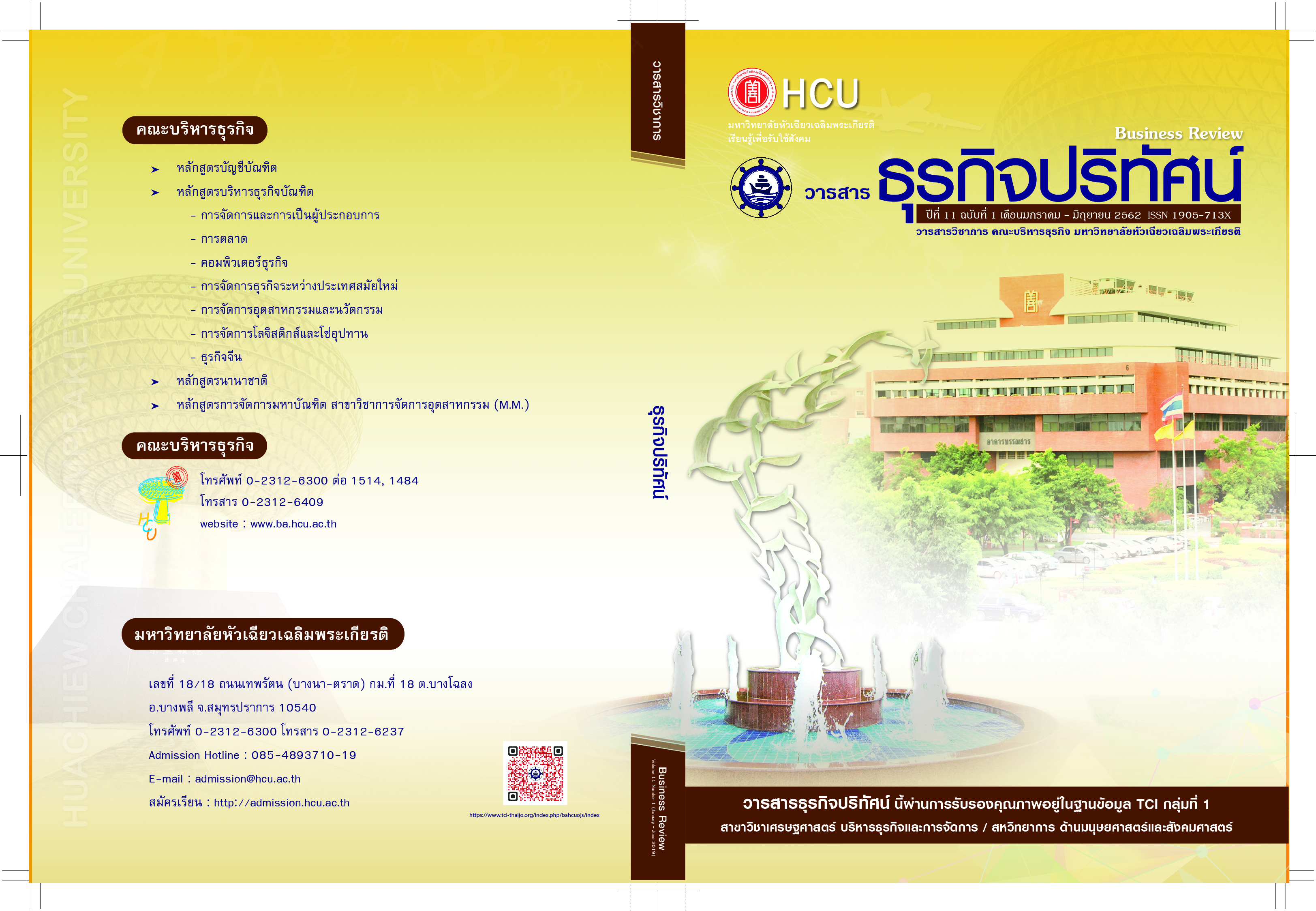A Causal Factors Model Inflf luencing Consumer Loyalty toward AliExpress Application of China in Thailand
Keywords:
Perceive Quality, Perceive Value, Customer Satisfaction, Consumer LoyaltyAbstract
The purpose of this research was to study the factors influencing of the variable needs
of consumer loyalty of AliExpress application use and to develop a model of factors that
influence the loyalty of consumers using AliExpress application express in Thailand. The
research instrument was a questionnaire to collect data from 400 consumers who using
AliExpress application. Results indicated that the structure (Structure Equation model: SEM)
showed Customer Satisfaction and the Perceive Value had a direct positive influence on
Consumer Loyalty. Furthermore, the Perceive Quality had an indirect positive influence on
Consumer Loyalty toward Customer Satisfaction and Perceive Value. The final model can
explain the Loyalty of Consumers with 74 percent (R2 = 0.74).
References
อีคอมเมิร์ซ โชว์ความพร้อมไทยก้าวขึ้นเป็นเจ้าอีคอมเมิร์ซอาเซียน. สืบค้นเมื่อ 15 ธันวาคม
2561, เว็บไซต์: https://www.etda.or.th/content/thailand-internet-user-profile-2017-and-valueof-
e-commerce-survey-in-thailand-2017l-press-conference.html
กาญจนา ทวินันท์ และ แววมยุรา ค?ำสุข. (2558). คุณภาพการบริการที่ส่งผลต่อความพึงพอใจของลูกค้า
ในธุรกิจการท่องเที่ยวแบบพ?ำนักระยะยาวในการท่องเที่ยวในประเทศไทย. วารสารธุรกิจปริทัศน์,
7(2), 151-167.
ธานินทร์ ศิลป์จารุ. (2552). การวิจัยและวิเคราะห์ข้อมูลทางสถิติด้วย SPSS. พิมพ์ครั้งที่ 10. กรุงเทพฯ:
เอส.อาร์.พริ้นติ้ง แมสโปรดักส์.
ร่มฉัตร จันทรานุกุล. (2561). New China Insights: เว็บซื้อขายออนไลน์ PinDuoDuo น้องใหม่มาแรงใน
วงการ shopping online จีนเป็นอย่างไร?. สืบค้นเมื่อ 20 ธันวาคม 2561, เว็บไซต์: https://
mgronline.com/china/detail/9610000077001.
ศูนย์วิจัยกสิกรไทย. (2559). (ออนไลน์). Online Shopping ช่องทางการตลาดยุคดิจิตอลบูม จับตาผู้บริโภค
Shop ผ่านโมบาย หรือ M-Shopping มากขึ้น. สืบค้นเมื่อ 15 ธันวาคม 2561, เว็บไซต์: https://
www.kasikornresearch.com/th/analysis/kecon/business/Pages/33743.
Best, J. W., & Kahn, J. V. (1998). Research in education. 8th ed. Boston: Allyn and Bacon.
Chuah, S. H. W., Marimuthu, M., Kandampully, J., & Bilgihan, A. (2017). What drives Gen Y
loyalty? Understanding the mediated moderating roles of switching costs and alternative
attractiveness in the value-satisfaction-loyalty chain. Journal of Retailing and Consumer
Services, 36, 124-136.
Cochran, W. G. (1977). Sampling techniques (3rd ed.). New York: John Wiley & Sons.
Fornell, C., Johnson, M. D., Anderson, E. W., Cha, J., & Bryant, B. E. (1996). The American customer
satisfaction index: nature, purpose, and findings. Journal of marketing, 60(4), 7-18.
Hair, J. F., Sarstedt, M., Ringle, C. M., & Mena, J. A. (2012). An assessment of the use of partial
least squares structural equation modeling in marketing research. Journal of the academy
of marketing science, 40(3), 414-433.
Han, H., Meng, B., & Kim, W. (2017). Bike-traveling as a growing phenomenon: Role of attributes,
value, satisfaction, desire, and gender in developing loyalty. Tourism management, 59,
91-103.
Huber, F., Herrmann, A., & Morgan, R. E. (2001). Gaining competitive advantage through customer
value oriented management. Journal of consumer marketing, 18(1), 41-53.
Homburg, C., & Giering, A. (2001). Personal characteristics as moderators of the relationship between
customer satisfaction and loyalty—An empirical analysis. Psychology and Marketing,
18(1), 43–66.
Juhl, H. J., Kristensen, K., & stergaard, P. (2002). Customer satisfaction in European food retailing.
Journal of retailing and consumer services, 9(6), 327-334.
Kao, T. W. D., & Lin, W. T. (2016). The relationship between perceived e-service quality and brand
equity: A simultaneous equations system approach. Computers in Human Behavior, 57,
208-218.
Kotler, P., & Armstrong, G. (2010). Principles of marketing. New Jersey, NJ: Pearson education.
Lam, S. Y., Shankar, V., Erramilli, M. K., & Murthy, B. (2004). Customer value, satisfaction,
loyalty, and switching costs: An illustration from a business-to-business service context.
Journal of the Academy of Marketing Science, 32(3), 293–311.
Le Chi, C. (2016). A formative model of the relationship between destination quality, tourist
satisfaction and intentional loyalty: an empirical test in Vietnam. Journal of hospitality
and tourism management, 26, 50-62.
Lee, J., Lee, J., & Feick, L. (2001). The impact of switching costs on the customer satisfaction-loyalty
link: Mobile phone service in France. Journal of Services Marketing, 15(1), 35–48.
Likert, R. E. N. S. I. S. (1972). Likert technique for attitude measurement. Social Psychology:
Experimentation, Theory, Research, Sahakian, WS (Ed.). Intext Educational Publishers,
Scranton, USA., ISBN-13: 9780700223879, 101-119.
Lomax, R. G., & Schumacker, R. E. (2012). A beginner's guide to structural equation modeling. New
York, NY: Routledge Academic.
Parasuraman, A., Zeithaml, V. A., & Berry, L. L. (1985). A conceptual model of service quality and
its implications for future research. Journal of marketing, 49(4), 41-50.
Picón-Berjoyo, A., Ruiz-Moreno, C., & Castro, I. (2016). A mediating and multigroup analysis of
customer loyalty. European management journal, 34(6), 701-713.
Ratanavaraha, V., Jomnonkwao, S., Khampirat, B., Watthanaklang, D., & Iamtrakul, P. (2016). The
complex relationship between school policy, service quality, satisfaction, and loyalty for
educational tour bus services: A multilevel modeling approach. Transport Policy, 45,
116-126.
Ryu, K., & Han, H. (2011). New or repeat customers: How does physical environment influence their
restaurant experience?. International Journal of Hospitality Management, 30(3), 599-611.
Segoro, W. (2013). The influence of perceived service quality, mooring factor, and relationship
quality on customer satisfaction and loyalty. Procedia-Social and Behavioral Sciences,
81, 306-310.
Vera, J., & Trujillo, A. (2017). Searching most influential variables to brand loyalty measurements:
An exploratory study. Contaduría y administración, 62(2), 600-624.
Wahab, N. A., Hassan, L. F. A., Shahid, S. A. M., & Maon, S. N. (2016). The relationship between
marketing mix and customer loyalty in hijab industry: The mediating effect of customer
satisfaction. Procedia Economics and Finance, 37, 366-371.
Williams C, Buswell J. (2003). Service Quality in Leisure and Tourism. UK: CABI Publishing.
Downloads
Published
How to Cite
Issue
Section
License
All articles published in the Business Administration and Management Journal Review are copyrighted by the journal.
The views and opinions expressed in each article are solely those of the individual authors and do not represent those of Huachiew Chalermprakiet University or any other faculty members. Each author is fully responsible for the content of their own article. Any errors or issues found are the sole responsibility of the respective author.




